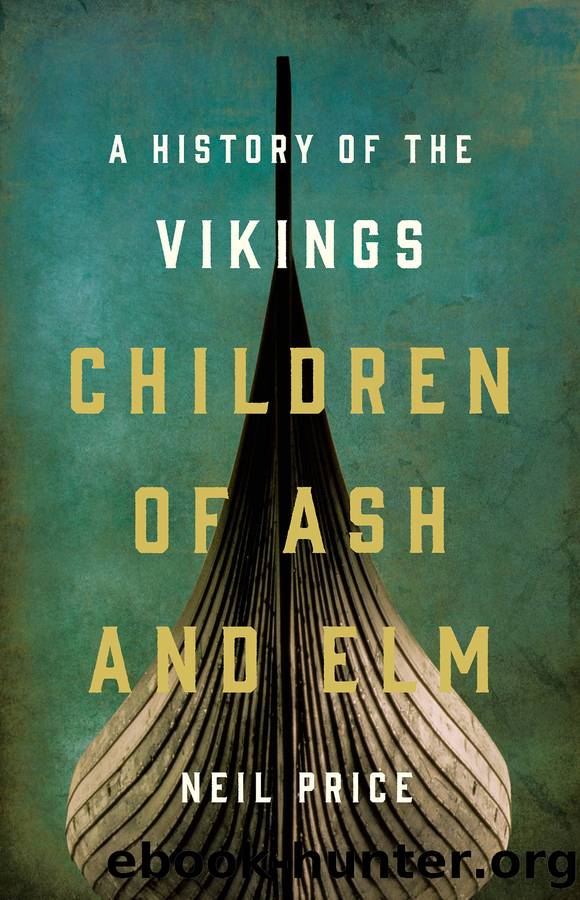Children of Ash and Elm: A History of the Vikings by Neil Price

Author:Neil Price [Price, Neil]
Language: eng
Format: epub
ISBN: 9780465096985
Amazon: 0465096980
Publisher: Basic Books
Published: 2020-08-24T23:00:00+00:00
At this point we should briefly consider some of the other theories that have been put forward as explanations for the raids, and therefore as catalysts for the Viking Age itself. Each of these âtriggersâ either has inherent problems or else is an insufficient explanation in isolation.
One of the most persistent relates to technology, specifically Scandinavian shipping design. The argument is that innovations in watercraftâthe introduction of the sail and the creation of shallow-draught vessels constructed of overlapping clinker-built planks for speed and manoeuvrabilityâmade it practically possible for the Vikings to sail abroad in this way; they would perhaps have launched the raids earlier, but did not have the ability to do so. Following this line of thinking, advances in boatbuilding provided a âpush factorâ that drove the Scandinavians out into the world: they had the ships, so they were going to use them. There are several problems with this. First, maritime warfare was nothing new in the late eighth century, or even the 750s. The bog sacrifices of Denmark indicate serious levels of naval engagement even in the early Iron Age, and it is no great step from the Danish shore to the rest of the European coast. Similarly, the Oseberg-style boats of the early Viking Age were certainly marvellous craft, but the truly lethal warships were a development of the later ninth and tenth centuries. There is no doubt at all that the Scandinavians were master mariners, and their ships were indeed markedly better than those of the surrounding cultures of north-west Europe, but sea travel had been a commonplace for centuries, and piracy and maritime military ventures were hardly Viking inventions. Ships and sea power were at the core of what real Vikings did, but they do not alone explain the why and when.
Then there is an environmental argument that sees a warming of the climate making new ventures into previously inhospitable environments like the North Atlantic suddenly more viable and attractive. As part of the effect, it is claimed, the outgoing Scandinavians engaged in raiding and settlement elsewhere on their travels. However, the much-debated Medieval Warm Period did not begin to manifest until over a century after the raids beganâperhaps even longer. Iceland and Greenland were already settled by the time the temperature began to rise. The climatic influence of the sixth-century âdust veilâ is clear, and we have explored its contributions to the society that would eventually generate the Viking phenomenon, but by the mid-eighth century it was buried deep in the mix.
Some scholars see the European emporia not as part of a larger economic realignment, but as a âpull factorâ corresponding to the supposed âpushâ of the ships. The argument is simple: the Vikings started raiding because there was a rapid expansion in places worth plunderingâwhat todayâs militaries call a target-rich environment. However, this does not fully align with the chronology. It is clear that the emporia were repeatedly raided (Dorestad was especially unfortunate) and that as conduits for the manufacturing wealth of the import-export trade they made for both tempting and profitable objectives.
Download
This site does not store any files on its server. We only index and link to content provided by other sites. Please contact the content providers to delete copyright contents if any and email us, we'll remove relevant links or contents immediately.
| Belgium | France |
| Germany | Great Britain |
| Greenland | Italy |
| Netherlands | Romania |
| Scandinavia |
Room 212 by Kate Stewart(5072)
The Crown by Robert Lacey(4761)
Endurance: Shackleton's Incredible Voyage by Alfred Lansing(4720)
The Iron Duke by The Iron Duke(4321)
The Rape of Nanking by Iris Chang(4169)
Joan of Arc by Mary Gordon(4055)
Killing England by Bill O'Reilly(3969)
Say Nothing by Patrick Radden Keefe(3937)
I'll Give You the Sun by Jandy Nelson(3394)
Shadow of Night by Deborah Harkness(3326)
Hitler's Monsters by Eric Kurlander(3291)
Mary, Queen of Scots, and the Murder of Lord Darnley by Alison Weir(3173)
Blood and Sand by Alex Von Tunzelmann(3167)
Eleanor & Park by Rainbow Rowell(3113)
Darkest Hour by Anthony McCarten(3096)
Margaret Thatcher: The Autobiography by Thatcher Margaret(3049)
Book of Life by Deborah Harkness(2893)
Red Famine: Stalin's War on Ukraine by Anne Applebaum(2890)
The One Memory of Flora Banks by Emily Barr(2829)
